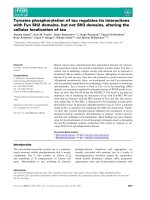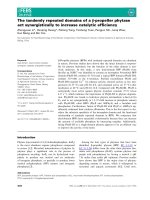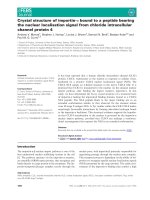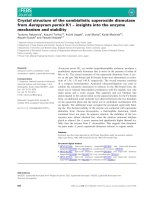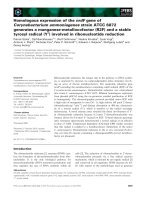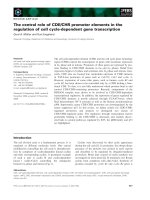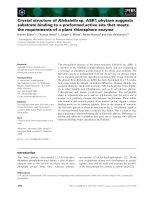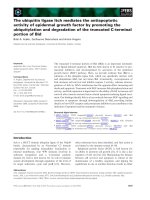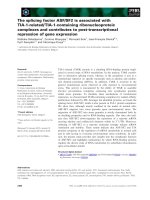Báo cáo khoa học:" The directionality of the nuclear transport of the influenza A genome is driven by selective exposure of nuclear localization sequences on nucleoprotein" pptx
Bạn đang xem bản rút gọn của tài liệu. Xem và tải ngay bản đầy đủ của tài liệu tại đây (2.2 MB, 12 trang )
BioMed Central
Page 1 of 12
(page number not for citation purposes)
Virology Journal
Open Access
Research
The directionality of the nuclear transport of the influenza A
genome is driven by selective exposure of nuclear localization
sequences on nucleoprotein
Winco WH Wu and Nelly Panté*
Address: Department of Zoology, University of British Columbia, 6270 University Boulevard, Vancouver, British Columbia, V6T 1Z4, Canada
Email: Winco WH Wu - ; Nelly Panté* -
* Corresponding author
Abstract
Background: Early in infection, the genome of the influenza A virus, consisting of eight complexes
of RNA and proteins (termed viral ribonucleoproteins; vRNPs), enters the nucleus of infected cells
for replication. Incoming vRNPs are imported into the nucleus of infected cells using at least two
nuclear localization sequences on nucleoprotein (NP; NLS1 at the N terminus, and NLS2 in the
middle of the protein). Progeny vRNP assembly occurs in the nucleus, and later in infection, these
are exported from the nucleus to the cytoplasm. Nuclear-exported vRNPs are different from
incoming vRNPs in that they are prevented from re-entering the nucleus. Why nuclear-exported
vRNPs do not re-enter the nucleus is unknown.
Results: To test our hypothesis that the exposure of NLSs on the vRNP regulates the
directionality of the nuclear transport of the influenza vRNPs, we immunolabeled the two NLSs of
NP (NLS1 and NLS2) and analyzed their surface accessibility in cells infected with the influenza A
virus. We found that the NLS1 epitope on NP was exposed throughout the infected cells, but the
NLS2 epitope on NP was only exposed in the nucleus of the infected cells. Addition of the nuclear
export inhibitor leptomycin B further revealed that NLS1 is no longer exposed in cytoplasmic NP
and vRNPs that have already undergone nuclear export. Similar immunolabeling studies in the
presence of leptomycin B and with cells transfected with the cDNA of NP revealed that the NLS1
on NP is hidden in nuclear exported-NP.
Conclusion: NLS1 mediates the nuclear import of newly-synthesized NP and incoming vRNPs.
This NLS becomes hidden on nuclear-exported NP and nuclear-exported vRNPs. Thus the
selective exposure of the NLS1 constitutes a critical mechanism to regulate the directionality of
the nuclear transport of vRNPs during the influenza A viral life cycle.
Background
The influenza A virus exploits the cellular nuclear trans-
port machinery several times during infection (reviewed
in [1]). Early in infection, the influenza A viral genome –
consisting of eight complexes of RNA and proteins (ribo-
nucleoproteins; vRNPs) – is released into the cytoplasm
and imported into the nucleus for replication. Subse-
quently, newly-synthesized viral proteins from the cyto-
plasm enter the nucleus to form newly-synthesized
vRNPs. Later in infection, newly-assembled vRNPs are
Published: 2 June 2009
Virology Journal 2009, 6:68 doi:10.1186/1743-422X-6-68
Received: 9 April 2009
Accepted: 2 June 2009
This article is available from: />© 2009 Wu and Panté; licensee BioMed Central Ltd.
This is an Open Access article distributed under the terms of the Creative Commons Attribution License ( />),
which permits unrestricted use, distribution, and reproduction in any medium, provided the original work is properly cited.
Virology Journal 2009, 6:68 />Page 2 of 12
(page number not for citation purposes)
exported from the nucleus to the cytoplasm to allow for
their packaging into progeny virions. The vRNPs contain
multiple copies (up to 97) of viral nucleoprotein (NP; 56
kDa) forming a core around which the RNA is helically
wrapped (reviewed in [2]). Each NP monomer has at least
two nuclear localization sequences (NLS1, spanning resi-
dues 1–13 at the N terminus, and NLS2, spanning resi-
dues 198–216 in the middle of the protein) that mediate
the nuclear import of NP and vRNPs [3-7]. We have pre-
viously found that both NLS1 and NLS2 on NP are
responsible for mediating the nuclear import of vRNPs
purified from influenza A virions in permeabilized cells
[7]. We also found that NLS1 of NP is the principal medi-
ator of the nuclear import of incoming vRNPs because
NLS1 has higher surface accessibility than NLS2, both
within each vRNP molecule and on a greater number of
vRNP molecules [8].
Within the nucleus, the original incoming and newly-syn-
thesized negative-sense vRNAs act as templates to tran-
scribe the positive mRNA strand, which is selectively
exported into the cytoplasm and used to translate new
viral proteins (reviewed in [9]). Some of the newly-syn-
thesized viral proteins (NP; the RNA polymerases PA,
PB1, and PB2; the nonstructural protein NS1; the matrix
protein M1) are then imported into the nucleus through
their respective NLSs. In the nucleus, the newly-synthe-
sized NP, PB1, PB2, PA, and the vRNA assemble into new
vRNPs (reviewed in [10]). Subsequently, the newly-
assembled vRNPs use the cellular export receptor CRM1
to exit the nucleus through the nuclear pore complexes
[11-13].
Nuclear-exported vRNPs are different from incoming
vRNPs in that they are somehow prevented from being
imported back into the nucleus. It has been demonstrated
that association of the vRNPs with the viral protein M1
regulates nuclear trafficking of influenza vRNPs [14,15].
However details of how M1 prevents newly-assembled
vRNPs from re-entering the nucleus is unknown. Our
hypothesis is that the NLSs on NP are the key determi-
nants for the nuclear transport directionality of the vRNPs
by possessing differential exposure. To test this hypothe-
sis, we analyzed the exposure of the NLSs on NP in tissue
culture cells infected with influenza A virus. We found
that an exposed NLS1 on NP allows newly-synthesized NP
to enter the nucleus, but NLS1 becomes masked or hidden
once the progeny vRNPs undergo nuclear export. Hidden
NLSs on the nuclear-exported vRNPs prevents the nuclear
re-entry of the progeny vRNPs. This selective exposure and
masking of NLS1 on vRNPs thus constitutes a critical
mechanism to regulate the directionality of the nuclear
transport of the influenza vRNPs.
Results
Specificity of NP antibodies
We have previously generated and characterized two pol-
yclonal anti-peptide antibodies that specifically recognize
NLS1 and NLS2 on NP [7,8]. In this study, we used these
anti-NLS antibodies to analyze the exposure of these NLSs
within cells infected with influenza A virus or transfected
with the cDNA of NP. Total NP was detected by using a
monoclonal antibody specific for NP. To ensure that all
three of the NP monoclonal, anti-NLS1, and anti-NLS2
antibodies were specific for NP and not for components
of the cell, we first compared the antibody labeling in
infected cells with that in mock-infected cells. We found
that each of the respective antibodies gave a strong signal
in infected cells compared with mock-infected cells in
which no virus was added (Fig. 1). A similar specificity of
the anti-NP monoclonal, anti-NLS1, and anti-NLS2 anti-
bodies was observed in cells transfected with the cDNA of
NP compared with mock-transfected cells (results not
shown).
Besides testing for the specificity of the anti-NP antibod-
ies, the results from Fig. 1 also indicated that NLS1 was
generally more exposed than NLS2, and exposed in a
greater number of influenza A virus-infected cells. This is
in agreement with our previous studies examining the
immunogold labeling of purified vRNPs with the anti-
NLS1 or anti-NLS2 antibodies [8], and with our conclu-
sion that NLS1 is stronger that NLS2 in mediating the
nuclear import of the influenza vRNPs [7].
Exposure of NLS1 and NLS2 in influenza-infected cells
We performed double-immunolabeling studies with the
monoclonal NP antibody in conjunction with either the
polyclonal NP anti-NLS1 or with the polyclonal NP anti-
NLS2 antibody to analyze the exposure of the NLSs in
cells infected with the influenza A virus. As illustrated in
Fig. 2, the NP monoclonal antibody detected NP in both
the nucleus and cytoplasm of infected cells (Fig. 2c–d),
with 28% of the infected cells showing only nuclear stain-
ing (Fig. 3a). Similarly, the NLS1 epitope on NP was
exposed in both the nucleus and cytoplasm (Fig. 2e). In
contrast, the NLS2 epitope was only exposed in the
nucleus of the infected cells (Fig. 2f). Quantitative analy-
sis showed that 100% of the infected cells labeled with the
anti-NLS2 antibody had only nuclear staining of anti-
NLS2, while 35% of the infected cells labeled with the
anti-NLS1 antibody had only nuclear staining of anti-
NLS1 (Fig. 3a).
To distinguish between incoming vRNPs and newly syn-
thesized NP and progeny vRNPs, we next performed a
similar double-immunolabeling experiment with cells
infected with influenza A virus in the presence of
cycloheximide (a protein synthesis inhibitor). As illus-
Virology Journal 2009, 6:68 />Page 3 of 12
(page number not for citation purposes)
trated in Fig. 4, there was no NP fluorescence signal in
cells treated with cycloheximide. This indicates that the
NP being labeled in the infected cells (Fig. 2) represents
indeed newly-synthesized NP. Therefore, this limits the
type of cytoplasmic NP detected in infected cells to be
either newly-synthesized NP or newly-assembled vRNPs
that have undergone nuclear export.
From the above results, it was unclear why these infected
cells did not contain an exposed NLS2 in the cytoplasm
even though the cells contained NP in the cytoplasm. The
experiment with cycloheximide helped us to conclude
that the cytoplasmic NP does not represent incoming
vRNPs. To distinguish whether the cytoplasmic NP is
newly-synthesized NP or nuclear-exported vRNPs, we
used leptomycin B (LMB) to inhibit the nuclear export of
vRNPs. These experiments with LMB detect newly synthe-
sized vRNPs that is trapped in the nucleus. LMB has been
successfully used in the past to inhibit the nuclear export
of vRNPs in infected cells [11,13]. We repeated these
experiments in the presence of LMB, to block vRNP
nuclear export and to determine whether the cytoplasmic
NP in the infected cells represented newly-synthesized NP
or nuclear-exported vRNPs. As documented in Fig. 2k–l,
and Fig. 3a, we found that in the presence of LMB 78% of
the infected cells showed only nuclear, and no cytoplas-
Specificity of NP antibodiesFigure 1
Specificity of NP antibodies. Immunofluorescence microscopy of HeLa cells infected with the influenza A virus and immu-
nolabeled with the monoclonal NP antibody, or the polyclonal anti-peptide antibodies that recognize the NLS1 and the NLS2
epitopes of NP. DAPI, a DNA marker, was used to determine the total number of cells present. As a control, a mock infection
without influenza A virus was also performed. Cells were fixed and prepared for immunofluorescence microscopy 17 hours
after infection.
Virology Journal 2009, 6:68 />Page 4 of 12
(page number not for citation purposes)
mic, NP. Quantitative analysis showed that 22% of the
infected cells, however, also still showed cytoplasmic NP
in addition to nuclear NP accumulation (Fig. 3b). Because
we were inhibiting nuclear export, this cytoplasmic NP
represents newly-synthesized NP that had not yet under-
gone nuclear import.
Consistent with the notion that there were two pools of
cytoplasmic NP in infected cells untreated with LMB
(newly-synthesized NP and newly-assembled vRNPs that
have undergone nuclear export), the experiment in the
presence of LMB yielded cells in which the fluorescence
intensity of the cytoplasmic NP was less intense than from
cells without LMB. Of particular note, this cytoplasmic NP
contained an exposed NLS1 (Fig. 2m). In fact, quantita-
tive analysis showed that 26% of infected cells in the pres-
ence of LMB still contained both cytoplasmic and nuclear
immunostaining with the anti-NLS1 antibody (Fig. 3b).
This indicates that newly-synthesized cytoplasmic NP that
had not yet undergone nuclear import contains an
exposed NLS1 epitope.
A longer time point in infected cells (30 hours instead of
17 hours) was also performed, and there was even less,
but still a small amount of cytoplasmic NP staining from
both the monoclonal and the anti-NLS1 antibodies
(results not shown), indicating that more NP had under-
gone nuclear import. Taken together, these results indi-
Exposure of NLS1 and NLS2 in influenza-infected cellsFigure 2
Exposure of NLS1 and NLS2 in influenza-infected cells. HeLa cells infected with influenza A virus for 17 hours, in the
absence (a-h) or presence (i-p) of the nuclear export inhibitor LMB, were immunolabeled with DAPI (a-b and i-j; blue), a
monoclonal anti-NP antibody (c-d and k-l; red), and either the polyclonal anti-NLS1 antibody (e and m; green) or the polyclo-
nal anti-NLS2 antibody (f and n; green). Merged images depict merge of the red and green channels for each respective set of
cells.
Virology Journal 2009, 6:68 />Page 5 of 12
(page number not for citation purposes)
Quantification of the exposure of NLS1 and NLS2 in influenza-infected cellsFigure 3
Quantification of the exposure of NLS1 and NLS2 in influenza-infected cells. Bar graphs of the percentage of
infected cells showing fluorescent staining only in the nucleus (a) or both in the cytoplasm and the nucleus (b) for the experi-
mental conditions described in Fig. 2. Data shows the mean values and standard error scored from 152 and 82 infected cells in
the absence and presence of LMB, respectively.
Virology Journal 2009, 6:68 />Page 6 of 12
(page number not for citation purposes)
cate that NLS1 (but not NLS2) exposure is a prerequisite
for successful nuclear import of newly-synthesized NP.
Exposure of NLS1 and NLS2 in NP-transfected cells
To distinguish any differences in the localization between
NP only and NP as part of the vRNP complex, we repeated
the immunolocalization experiments in cells transfected
with NP cDNA. Similar to infected cells, 71% of the trans-
fected cells showed NP in both the cytoplasm and
nucleus, as represented by immmunolabeling with the
monoclonal anti-NP antibody (Fig. 5c–d, and Fig. 6b).
However, NP NLS1 and NLS2 were only exposed in the
nucleus, and not cytoplasm, of transfected cells (Fig. 5e–f,
and Fig. 6). This contrasted to infected cells, which yielded
65% of the cells with NP NLS1 exposed in the cytoplasm
(Fig. 2e and Fig. 3b). According to our results above, this
would indicate that the cytoplasmic NP in these trans-
fected cells represented NP that had been nuclear
exported, and not newly-synthesized NP, since NLS1 was
not exposed in the cytoplasm of transfected cells (Fig. 5e
and Fig. 6b) even though 71% of the transfected cells
showed NP existing in the cytoplasm (Fig 5c–d, and Fig.
6b). To confirm this and distinguish between the two
populations of cytoplasmic NP (nuclear exported or
newly-synthesized), we blocked NP nuclear export with
LMB. As expected, LMB completely inhibited NP nuclear
export, with all the NP being retained in the nucleus of the
transfected cells (Fig. 5k–l, and Fig. 6a). This indicates that
Localization of newly-synthesized NP in influenza-infected cellsFigure 4
Localization of newly-synthesized NP in influenza-infected cells. Immunofluorescence microscopy of HeLa cells
infected with the influenza A virus in the absence or presence of the protein synthesis inhibitor, cycloheximide. Cells were
fixed and immunolabeled with DAPI and the monoclonal anti-NP antibody 17 hours after infection.
Virology Journal 2009, 6:68 />Page 7 of 12
(page number not for citation purposes)
all the cytoplasmic NP in transfected cells in the absence
of LMB (Fig. 5c–d) indeed represented nuclear-exported
NP. Since these cytoplasmic NP molecules did not show
immunolabeling of NLS1 or NLS2 (Fig. 5e–f), nuclear
exported-NP has its NLSs hidden or masked.
Exposure of NLS1 and NLS2 within the nucleolus
We also observed that in infected cells NP localized to dis-
tinct nuclear spots, which were reminiscent of nucleoli. To
verify this we performed double immunolabeling with
the anti-NLS antibodies and a monoclonal antibody
against the nucleolar protein fibrillarin. As illustrated in
Fig. 7a, we found that in influenza-infected cells, NLS1
was not exposed in the nucleolus. NLS2 was, however,
exposed both in the nucleoplasm and the nucleolus. This
is in contrast to NP-transfected cells, which have NLS1
and NLS2 exposed in the nucleoplasm, without any expo-
sure in the nucleolus (Fig. 7b). This indicates that one or
more components from the influenza virus play a role in
allowing NLS2 to become exposed in the nucleolus of
influenza A virus-infected cells.
Discussion
We have previously shown that the NLS1, compared to
the NLS2, epitope on NP is more highly exposed through-
out each vRNP molecule [8]. This has the consequence
that NLS1 is a stronger mediator than NLS2 for nuclear
import of vRNPs in vitro [7]. In this study, we analyzed the
degree of exposure of NLS1 and NLS2 in influenza-
infected cells, and found that these NLSs are also differen-
Exposure of NLS1 and NLS2 in NP-transfected cellsFigure 5
Exposure of NLS1 and NLS2 in NP-transfected cells. HeLa cells transfected with the cDNA of NP, in the absence (a-h)
or presence (i-p) of the nuclear export inhibitor LMB, were immunolabeled with DAPI (a-b and i-j; blue), a monoclonal anti-
NP antibody (c-d and k-l; red), and either the polyclonal anti-NLS1 antibody (e and m; green) or the polyclonal anti-NLS2 anti-
body (f and n; green). Merged images depict merge of the red and green channels for each respective set of cells.
Virology Journal 2009, 6:68 />Page 8 of 12
(page number not for citation purposes)
Quantification of the exposure of NLS1 and NLS2 in NP-transfected cellsFigure 6
Quantification of the exposure of NLS1 and NLS2 in NP-transfected cells. Bar graphs of the percentage of trans-
fected cells showing fluorescent staining only in the nucleus (a) or both in the cytoplasm and the nucleus (b) for the experi-
mental conditions described in Fig. 5. Data shows the mean values and standard error scored from 288 and 87 transfected cells
in the absence and presence of LMB, respectively.
Virology Journal 2009, 6:68 />Page 9 of 12
(page number not for citation purposes)
Exposure of NLS1 and NLS2 within the nucleolusFigure 7
Exposure of NLS1 and NLS2 within the nucleolus. Immunofluorescence microscopy of cells infected with the influenza
A virus (a) or transfected with the cDNA of NP (b) and immunolabeled with DAPI, the monoclonal anti-fibrillarin antibody
(red), and either the polyclonal anti-NLS1 antibody (green) or the polyclonal anti-NLS2 antibody (green). Merged images of
anti-fibrillarin (red) with the corresponding anti-NLS antibody (green) are shown.
Virology Journal 2009, 6:68 />Page 10 of 12
(page number not for citation purposes)
tially exposed in the different cell compartments during
the course of an infection. Interestingly, NLS2 was only
exposed in the nucleus, while NLS1 was exposed in the
cytoplasm and nucleus. By designing experiments that
allowed us to detect specific forms of cytoplasmic NP and
vRNPs, we found that NLS1 is exposed in newly-synthe-
sized cytoplasmic NP, confirming once more that NLS1,
but not NLS2, is especially critical for the nuclear import
of influenza NP [6]. The exposure and role of NLS2 in
nuclear trafficking of NP and vRNP is less clear. However,
our findings that NLS2 is exposed in the nucleolus of
infected, but not NP-transfected, cells is in agreement with
a role of this sequence for viral replication, as it has been
previously demonstrated [16].
We have also found in this study that nuclear-exported NP
contains a masked NLS1, thereby preventing this mole-
cule from re-entering the nucleus. Based on this result, we
conclude that the selective exposure and masking of NLS1
constitutes a critical mechanism to regulate the direction-
ality of nuclear trafficking of vRNPs during the influenza
A viral life cycle. Our results is consistent with a model
(Fig. 8) in which NLS1 is exposed in newly-synthesized
NP and also in incoming vRNPs to allow these molecules
to bind to cellular importins and enter the nucleus; upon
assembly of NP into newly-synthesized vRNPs in the
nucleus, NLS1 becomes masked, so after the vRNPs are
nuclear exported, they cannot return to the nucleus. The
hidden NLS1 epitope thereby critically regulates the direc-
tionality of the nuclear transport of newly-assembled
vRNPs, driving their uni-directional nuclear export and
allowing subsequent cytoplasmic assembly and budding
of the complete influenza A virion.
Several putative pathways to encrypt NLS1 on nuclear-
exported vRNPs and NP may occur. Since the masking of
NLS1 was also observed in transfected, and not only
infected, cells, a masked NLS1 epitope is independent of
the viral M1 matrix protein, viral RNA, or other influenza
A components. NLS1 masking on newly-synthesized
vRNP and NP is also unlikely due to NP oligomerization
because we have previously demonstrated that NP oli-
gomerized as vRNPs contains an exposed NLS1 [8].
Instead, this NLS masking is likely due to an NP post-
translational modification, its binding to a cellular pro-
tein, or a conformational change in NP. Which of these
mechanisms act to prevent nuclear re-entry awaits further
studies.
Conclusion
Our results indicate that NLS1 is exposed in cells after
influenza infection to mediate the nuclear import of
incoming vRNPs and newly-synthesized NP. This NLS
becomes hidden once progeny vRNPs have been exported
from the nucleus. Our data support the model that mask-
ing of the NLS1 epitope prevents nuclear re-entry of
newly-synthesized vRNPs. The molecular mechanism of
this masking awaits further studies, but we believe that
this study provides the basic underlying mechanism that
regulates the directionality of the nuclear trafficking of
influenza vRNPs. We conclude that selective exposure and
masking of the NLS1 on the vRNP constitutes a critical
mechanism to regulate the directionality of the nuclear
transport of vRNPs during the influenza A viral life cycle
(Fig. 8).
Methods
Cells, viruses, antibodies
HeLa cells (American Type Culture Collection) were cul-
tured in DMEM (HyClone) supplemented with 9% fetal
bovine serum (FBS; Sigma) and maintained at 37°C in a
humidified atmosphere with 5% CO
2
. Influenza A (A/
WSN/1933) NP cDNA in the pCAGGS vector was kindly
provided by Dr. G. Whittaker (Cornell University). The
affinity-purified rabbit polyclonal antibodies against the
NLSs of NP (NLS1,
1
MASQGTKRSYEQM
13
and NLS2,
198
KRGINDRNFWRGENGRKTR
216
) were produced by
Pacific Immunology, and have been characterized previ-
ously [7,8]. The mouse monoclonal NP and fibrillarin
antibodies were purchased from Acris and Abcam, respec-
tively. Influenza A virus (A/Aichi/1968) was obtained
from Charles River Laboratories.
Influenza infection
HeLa cells were plated at 30% confluency the day before
infection in growth media containing 9% FBS onto 12-
mm glass cover slips in 12-well plates. The next day, the
cells were washed with phosphate buffered saline (PBS),
and then 1 ml of growth media containing 0.2% FBS was
applied to each well. 30 μl of the influenza A virus at 2
mg/ml (MOI of 1) were applied to the cells. The virus was
allowed to adsorb to the surface of the cells for 40 minutes
at room temperature, with gentle rocking every 10–15
minutes. The media containing the virus was then
removed, and replaced with 1 ml of media containing 2%
FBS. The cells were incubated for 17 or 30 hours in a 37°C
incubator containing 5% CO
2
. After these incubation
times, the cells were prepared for immunofluorescence
microscopy as described below.
For some experiments, the protein synthesis inhibitor
cycloheximide (Sigma, St. Louis) at a final concentration
of 1 mM was added to the 2% FBS medium. To inhibit
nuclear export, leptomycin B (LMB; Sigma) was added to
the cells 6 hours after replacing the media containing 2%
FBS, and cells were incubated for a total of 17 or 30 hours
at 37°C. LMB was used at a concentration of 11 nM,
which is effective for the inhibition of the nuclear export
of NP and vRNPs, as previously reported [6,11].
Virology Journal 2009, 6:68 />Page 11 of 12
(page number not for citation purposes)
Transfections
Transfection of HeLa cells with NP-pCAGGS was carried
out on glass coverslips with Lipofectamine 2000 (Invitro-
gen) according to the manufacturer's protocol. For some
experiments, cycloheximide (final concentration 1 mM)
was added after media was changed, and the cells were
incubated for 24 hours at 37°C. To inhibit nuclear export,
LMB (final concentration 11 nM) was added 6 hours after
the change in media, and the cells were incubated for a
total of 30 hours at 37°C. After these incubation times,
the cells were prepared for immunofluorescence micros-
copy as described below.
Immunofluorescence microscopy
After infection or transfection, cells were washed three
times with PBS, fixed for 10 minutes with 4% paraformal-
dehyde, permeabilized with 0.2% Triton X-100 (Sigma)
in PBS containing 10% goat serum (Sigma), and labeled
with the NP or the fibrillarin monoclonal antibody and
either the NP polyclonal anti-NLS1 or the NP polyclonal
anti-NLS2 antibody for 1 hour, followed by incubation
with secondary antibodies (goat anti-mouse rhodamine
and goat anti-rabbit fluorescein, both from Invitrogen).
After washing, coverslips were mounted with Prolong
Gold antifade containing DAPI (Invitrogen). Fluorescence
microscopy was performed on a Zeiss Axioplan 2.
Competing interests
The authors declare that they have no competing interests.
Model of the exposure of the NLS1 on influenza A NP and its role in cellular nuclear transportFigure 8
Model of the exposure of the NLS1 on influenza A NP and its role in cellular nuclear transport. The exposure and
masking of the NP NLS1 mediates the directionality of the nuclear trafficking of influenza NP and vRNP. NP and vRNPs with an
exposed NLS1 are represented by green, and NP and vRNPs with a hidden NLS1 are represented by red.
Publish with BioMed Central and every
scientist can read your work free of charge
"BioMed Central will be the most significant development for
disseminating the results of biomedical research in our lifetime."
Sir Paul Nurse, Cancer Research UK
Your research papers will be:
available free of charge to the entire biomedical community
peer reviewed and published immediately upon acceptance
cited in PubMed and archived on PubMed Central
yours — you keep the copyright
Submit your manuscript here:
/>BioMedcentral
Virology Journal 2009, 6:68 />Page 12 of 12
(page number not for citation purposes)
Authors' contributions
WWHW carried out the experiments and drafted the man-
uscript. NP conceived the study and experimental design,
coordinated the study, and helped to draft the manu-
script. All authors read and approved the final manu-
script.
Acknowledgements
We thank Dr. Gary Whittaker for kindly providing the NP cDNA. This
work was supported by grants from the Canada Foundation for Innovation
(CFI), the Canadian Institutes of Health Research (CIHR), and the Natural
Sciences and Engineering Research Council of Canada (NSERC). NP is a
Michael Smith Foundation for Health Research (MSFHR) Senior Scholar.
References
1. Whittaker G, Bui M, Helenius A: The role of nuclear import and
export in influenza virus infection. Trends Cell Biol 1996, 6:67-71.
2. Wright PF, Neumann G, Yoshihiro K: Orthomyxoviruses. In Fields
Virology Edited by: Knipe DM, Howley PM. Philadelphia: Lippincott
Williams & Wilkins; 2007:1691-1740.
3. Neumann G, Castrucci MR, Kawaoka Y: Nuclear import and
export of influenza virus nucleoprotein. J Virol 1997,
71:9690-9700.
4. Wang P, Palese P, O'Neill RE: The NPI-1/NPI-3 (karyopherin
alpha) binding site on the influenza a virus nucleoprotein NP
is a nonconventional nuclear localization signal. J Virol 1997,
71:1850-1856.
5. Weber F, Kochs G, Gruber S, Haller O: A classical bipartite
nuclear localization signal on Thogoto and influenza A virus
nucleoproteins. Virology 1998, 250:9-18.
6. Cros JF, Garcia-Sastre A, Palese P: An unconventional NLS is crit-
ical for the nuclear import of the influenza A virus nucleo-
protein and ribonucleoprotein. Traffic 2005, 6:205-213.
7. Wu WWH, Sun YHB, Panté N: Nuclear import of influenza A
viral ribonucleoprotein complexes is mediated by two
nuclear localization sequences on viral nucleoprotein. Virol J
2007, 4:49.
8. Wu WWH, Weaver LL, Panté N: Ultrastructural analysis of the
nuclear localization sequences on influenza a ribonucleopro-
tein complexes. J Mol Biol 2007, 374:910-916.
9. Sidorenko Y, Reichl U: Structured model of influenza virus rep-
lication in MDCK cells. Biotechnol Bioeng 2004, 88:1-14.
10. Boulo S, Akarsu H, Ruigrok RW, Baudin F: Nuclear traffic of influ-
enza virus proteins and ribonucleoprotein complexes. Virus
Res 2007, 124:12-21.
11. Elton D, Simpson-Holley M, Archer K, Medcalf L, Hallam R, McCauley
J, Digard P: Interaction of the influenza virus nucleoprotein
with the cellular CRM1-mediated nuclear export pathway. J
Virol 2001, 75:408-419.
12. Ma K, Roy AM, Whittaker GR: Nuclear export of influenza virus
ribonucleoproteins: identification of an export intermediate
at the nuclear periphery. Virology 2001, 282:215-220.
13. Watanabe K, Takizawa N, Katoh M, Hoshida K, Kobayashi N, Nagata
K: Inhibition of nuclear export of ribonucleoprotein com-
plexes of influenza virus by leptomycin B. Virus Res 2001,
77:31-42.
14. Whittaker G, Bui M, Helenius A: Nuclear trafficking of influenza
virus ribonuleoproteins in heterokaryons. J Virol 1996,
70:2743-2756.
15. Martin K, Helenius A: Nuclear transport of influenza virus ribo-
nucleoproteins: the viral matrix protein (M1) promotes
export and inhibits import. Cell 1991, 67:117-130.
16. Ozawa M, Fujii K, Muramoto Y, Yamada S, Yamayoshi S, Takada A,
Goto H, Horimoto T, Kawaoka Y: Contributions of two nuclear
localization signals of influenza A virus nucleoprotein to viral
replication. J Virol 2007, 81:30-41.
